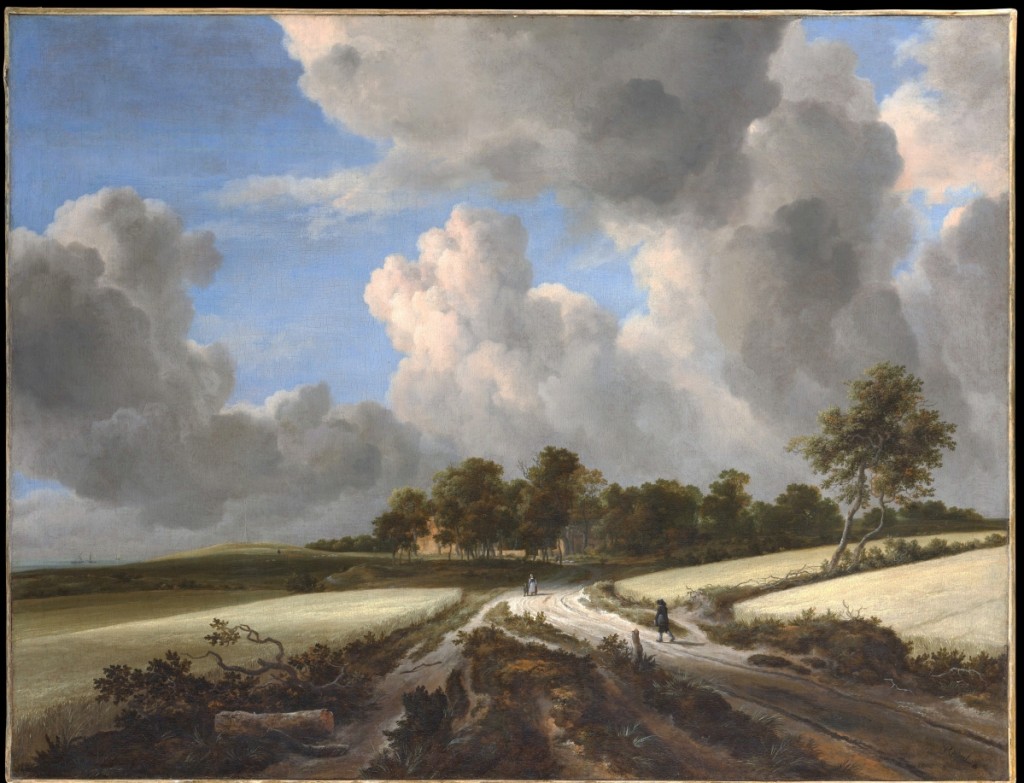
“Wheat Fields” by Jacob van Ruisdael (1628/29–1682), circa 1670. Oil on canvas, 39-3/8 by 51¼ inches. The Metropolitan Museum of Art, New York City, Bequest of Benjamin Altman, 1913 (14.40.623).
NEW YORK CITY – Dutch paintings of the Seventeenth Century – the Golden Age of Rembrandt, Hals and Vermeer – have been a highlight of the Metropolitan Museum of Art’s collection since the museum’s founding purchase in 1871. Continuing to October 1, 2020, “In Praise of Painting: Dutch Masterpieces at The Met” will bring together some of the museum’s greatest paintings to present this remarkable chapter of art history in a new light.
Through 67 works drawn exclusively from the Met’s permanent collection and organized thematically, the exhibition will orient visitors to key issues in Seventeenth Century Dutch culture – from debates about religion and conspicuous consumption to painters’ fascination with the domestic lives of women. The presentation will offer a fresh perspective on the canon and parameters of the Dutch Golden Age and as the museum approaches the 150th anniversary of its founding in 2020, provides an opportunity to celebrate a core aspect of the museum’s collection.
The exhibition will unfold in nine thematically organized galleries. The first themed gallery, “Faces of a New Nation,” will examine how portraiture was used to express identity and status at a moment when Dutch society was experiencing unprecedented social mobility and diversity. The next two galleries will familiarize visitors with the Dutch Republic’s religious and geographical landscapes in “Questions of Faith.”
“Staking a Claim” will look at the flat terrain of the Netherlands – the unlikely inspiration for the birth of landscape painting as an independent genre in Europe. Some Dutch painters embraced the open vistas and dramatic skies of their home turf, as seen in Jacob van Ruisdael’s monumental “Wheat Fields” (circa 1670).
Rembrandt’s impact on the canon of Dutch paintings will be the focus of “Masters, Pupils, Rivals.” The extraordinary quality of Rembrandt’s late self-portrait will be even more evident following the recent removal of a synthetic varnish dating to the mid-Twentieth Century. Particularly in the first half of the Seventeenth Century, Dutch collectors reveled in scenes of merriment and misbehavior among the lower classes. “The Comic Painting” gallery will display a selection of these down-to-earth and sometimes crude scenes.
“Contested Bodies” will showcase the diverse approaches that Dutch painters took in representing the human form. The exhibition then transitions from the human figure to commentary on human vanity and the pleasures of consumption as captured in still life painting, which, like landscape, was a new and experimental genre in the Dutch Golden Age. “The Eloquent Things” gallery will feature Margareta Haverman’s newly conserved “Vase of Flowers” (1716) – one of only two known paintings by the artist and the only painting by an early modern Dutch woman in the museum’s collection. Pieter Claesz’s exceptional powers of observation will be on full display in “Still Life with a Skull and a Writing Quill” (1628), a richly symbolic work about the brevity of life.
In “Lives of Women,” visitors will encounter one of the major themes of Seventeenth Century Dutch art: the everyday activities of women observed while keeping house, getting dressed or caring for children. These interior scenes will carry over into the final gallery, “Behind Closed Doors,” which will afford a peek into Seventeenth Century amorous pursuits and civilized leisure as depicted in “high-life genre paintings.”
The Met is at 1000 Fifth Avenue. For information, 212-535-7710 or www.metmuseum.org.












